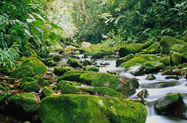About Costa Rica
COSTA RICA AT A GLANCE
|
Costa Rica is one of the oldest democracies in the Americas. It is a country proud of its heritage and tradition of negotiation over confrontation, social development over military spending and tolerance over hostility. It is the home to many international organizations such as the Inter-American Court of Human Rights, the University for Peace of the United Nations and the Earth Council. In 1502, on his fourth and last voyage to the New World, Christopher Columbus made the first European landfall in the area. Settlement of Costa Rica began in 1522. The Spanish optimistically called the place "Rich Coast." Finding little gold or other valuable minerals in Costa Rica, however, the Spanish turned to agriculture. For nearly three centuries, Spain administered the region as part of the Captaincy General of Guatemala under a military governor. The small landowners' relative poverty, the lack of a large indigenous labor force, the population's ethnic and linguistic homogeneity, and Costa Rica's isolation from the Spanish colonial centers in Mexico and the Andes all contributed to the development of an autonomous and individualistic agrarian society. An egalitarian tradition also arose. This tradition survived the widened class distinctions brought on by the 19th-century introduction of banana and coffee cultivation and consequent accumulations of local wealth. Costa Rica joined other Central American provinces in 1821 in a joint declaration of independence from Spain. Costa Rica abolished its military forces in 1949 and since then has devoted substantial resources to investment in health and education. It is a country that has placed a high priority in investing in public education, including the university system, as well as technical and vocational training. Its population of 4.4 million people enjoys a literacy rate of 96% and a life expectancy of 79.3 years. The Costa Rican government is ruled by a series of constitutional controls. The executive responsibilities rest on the President, supported by two Vice-presidents and a 57 Congressmen cabinet; all of them are elected every 4 years. The country has a strong legal system managed by the ‘Judicial Power’, which ensures law compliancen and covers both nationals and foreigners within the country’s territory. The 2008 World Bank Study for Global Governance Indicators ranks Costa Rica in the first place within Latin America for political stability. Costa Rica is blessed with impressive scenic beauty a fact that is not lost on the more than one million tourists that visit each year. Located in Central America in an area that covers 51.000 square kilometers (19.729 square miles), Costa Rica possesses approximately 6% of the world’s biodiversity. Because of Costa Rica’s small size, a diverse array of fabulous sites is within easy access. A trip to Costa Rica affords the opportunity to visit 12 different life zones, 20 national parks, 26 protected areas, nine forest reserves, eight biological reserves and seven wildlife sanctuaries. Costa Rica is the birthplace of ecotourism. The country is often cited as a model for conservation in harmony with community development and economic growth. Today Costa Rica is one of the only developing countries to have adopted a tax on hydrocarbons, partially funding the only national system of payment for environmental services, and becoming the largest buyer of forest carbon in the world. Moreover, Costa Rica has set the goal to become a carbon-neutral country by 2021. It is not surprising that tourism is Costa Rica’s main source of income and hard currency. Costa Rica receives over 1.7 million tourists per year, the majority of whom come from the United States and Canada. Earnings from tourism amount to more than $1.7 billion US dollars per year. It is estimated that up to 80% of all visitors to the country come to do eco-tourism related activities. One of the pillars of Costa Rica's economic development has been trade liberalization, which has allowed exports to surpass its 30% ratio of GDP in 1980 to a current 50% rate. This trade liberalization has been followed by a series of structural changes resulting in productivity growth, diversification of the economy and a higher level of investment. Today, Costa Rica exports thousands of distinctive products to the world and is highly recognized as one of the top 30 leading exporters of high-tech products. Foreign investors remain attracted by the country’s political stability and high education levels. All these changes have translated into important social achievements. In the last 20 years poverty was reduced from 40% to less than 20%. In 2009, Costa Rica was considered the country with the highest rate of happiness (Happy Planet Index). |
|
Costa Rica at a Glance |
|
|---|---|
|
Official Name: |
Republic of Costa Rica |
|
Capital: |
San José |
|
Area: |
51.100 square kilometers (19.729 square miles) |
|
Location: |
Central America, between Nicaragua and Panama, bordering both the Caribbean Sea and the Pacific Ocean |
|
Administrative Divisions: |
7 provinces (Alajuela, Cartago, Guanacaste, Heredia, Limón, Puntarenas, San José) divided into 81 subdivisions (cantones), which are also divided into 421 districts |
|
Population: |
4.89 Million (Mayo 2017) |
|
Official Language: |
Spanish |
|
Local Currency: |
Colón (named after Christopher Columbus) |
|
Official Religion: |
Roman Catholic, but there is freedom of expression of other beliefs |
|
System of Government: |
Democratic Republic |
|
Executive Branch: |
President and two Vice Presidents elected on the same ticket by popular vote for four-years terms. |
|
Legislative Branch: |
Unicameral Legislative Assembly (57 seats). Members are elected by direct, popular vote to serve four-year terms. |
|
Judicial Branch: |
Supreme Court (22 justices are elected for eight-year terms by the Legislative Assembly) and Tribunals. |
|
Army: |
Abolished in 1949 |
|
Independence: |
15 September 1821 (from Spain) |
|
Constitution: |
7 November 1949 |
|
Geography: |
Rugged highlands are found throughout most of the country, ranging from approximately 1,000 to 2,000 meters (3,000 to 6,000 feet above sea level). The Guanacaste Mountain Range, Central Mountain Range, and Talamanca Mountain Range are the main mountain ranges of the country. There are several active volcanoes (Arenal Volcano, Irazu Volcano, Rincon de la Vieja Volcano and Turrialba Volcano), and the country’s highest mountain (Chirripo Hill) has a height of 3,819 m/12,530 ft. The country has a relatively long coastline in both the Atlantic and Pacific oceans. |
|
Climate: |
Tropical and subtropical; dry season (December to April); rainy season (May to November); cooler in highlands |
|
Demographic and human development indicators* |
|
|---|---|
|
Density: |
90 inhabitants per square kilometer (230 inhabitants per sq. mile) |
|
Urban/Rural: |
59% urban, 39% rural |
|
Gender Distribution: |
49.86% male, 50.14% female |
|
Age Structure: |
0-14 years (27.7%), 15-64 years (67.1%), 65 years and over (6.2%) |
|
Life expectancy: |
79,3 years |
|
Literacy rate: |
96% |
|
Educational Institutions: |
9870 (2778 preschool, 4071 primary schools, 830 secondary schools, 2129 special education, 5 night schools, 2 para university, and 55 universities |
|
Education expenditures: |
6% of GDP |
|
Public health coverage: |
90.4% of population |
|
Health expenditure: |
21.5% of government budget |
|
Population served with piped water: |
99% |
|
Access to telephone service: |
92% of population |
* For additional indicators visit the website of the Instituto de Estadística y Censos (Costa Rican Bureau of Statistics and Census) and Programa Estado de la Nación.
|
Economic Indicators* |
|
|---|---|
|
GDP in billions of US$: |
29,3 (2009) |
|
Per Capita GDP (US$): |
6,900 (2009) |
|
Total FDI in billions of US$: |
1.7 (2009) |
|
Exports (FOB)in millions of US$: |
8,675.6 (2009) |
|
Imports (CIF) in millions of US$: |
11,394.7 (2009) |
|
Inflation rate: |
8,3% (2009) |
|
Computer parts, integrated circuits and electronic microstructures, bananas, pineapple, medical devices, drugs and medicines, medical prosthesis, textiles and apparel, other food processing and Gold coffee. |
|
|
Integrated circuits, petroleum oils and oils obtained from bituminous, computer parts and accessories, printed circuit boards (PCB), drugs and medicines, vehicles, soy beans, krafliner, mobile telecommunication devices, food processing, articles of iron or steel, and plastic products. |
|
|
Unemployment rate: |
6.5% |
* For economic and trade statistics please visit the following links: Banco Central (Costa Rican Central Bank), Ministerio de Comercio Exterior (Foreign Trade Ministry), Instituto Nacional de Estadísticas y Censos (National Bureau of Statistics and Census), Promotora del Comercio Exterior (Foreign Trade Corporation)
|
National Symbols |
|
|---|---|
|
Flag: |
The present flag was adopted in September 1848 when Costa Rica became a Republic. The flag is formed by five horizontal stripes: the first and the fifth are blue, the second and the fourth are white, and in the middle there is a red stripe that doubles the width of each of the other four stripes. |
|
Emblem: |
It was adopted in 1848. Three volcanoes and a vast valley stretching between two oceans form it, and in each of the oceans there is a merchant ship. In the horizon, there is a rising sun between the blue sky and the blue ocean. Two wreaths of myrtle leaves joined by a ribbon bearing the inscription "República de Costa Rica" enclose the national seal. Seven stars forming an arch represent the seven provinces of the republic. The crown is formed by a blue ribbon with the inscription "América Central". |
|
National Anthem: |
The music of the Costa Rican National Anthem (Himno Nacional de Costa Rica) was composed in 1852 by Don Manuel María Gutiérrez (1829-1887), director of the Marching Band. |
|
National Flower: |
Guaria Morada (Cattleya skinneri). This is a native species in the American continent and grows nationwide without any problem. |
|
National Tree: |
Guanacaste Tree (Enterolobium ciclocarpum). |
|
National Bird: |
Yiguirro (Turdus grayi). |
|
Typical Ox-Cart: |
In 1988 the Costa Rican ox-cart ("la carreta costarricense") was established as the national symbol of work. Drawn by a team of oxen, the ox-cart was used during the colonial period for the transportation of sugar cane, tobacco, and coffee. Thus, it became a very important factor in the development of agricultural activity of Costa Rica. In the present, the ox-cart is one of the most representative handcrafted objects in Costa Rican culture. |




